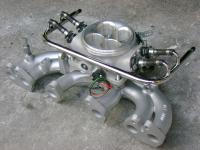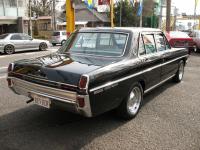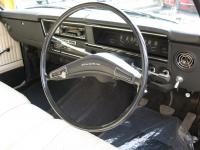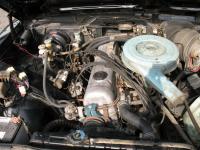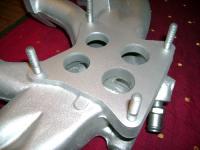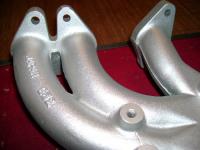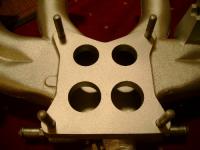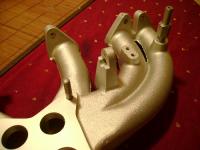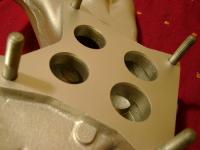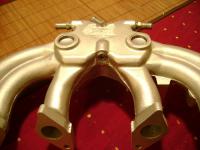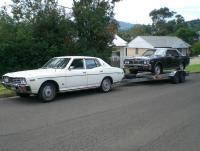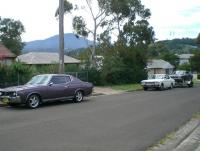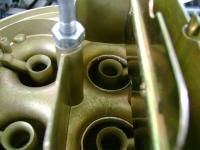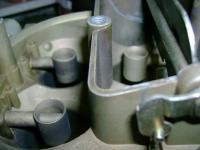Everything posted by ozconnection
-
Timing chain questions
The camshaft and harmonic balancer bolts are the same, same thread pitch and diameter except for the size of the head on them. The cam bolt will fit where the crank bolt goes and visa versa. Now you know why they have the same torque specs! Cheers Ps, what does 'run the valves' mean?
-
Timing chain questions
You did take a look at the size of that bolt, didn't you? 100 ft/lbs is the 'right' number! Advancing the cam is not really a bad thing, and the second position on a fresh chain is 4 crankshaft degrees. Not a lot, but you may find some more low down torque available. How do you like to drive? If you potter and rarely go over 4k rpm, then you've set up your cam well. If you drive hard all the time, then your cam is too small anyway! Or it won't be long before you'll be looking for power ups and the stock camshaft is very often one of the first "to upgrade". Personally, I love the little stock profiles and set them up in my car with lots of advance and combined with lots of ignition advance, creates a torquey, economical and responsive engine. It's all up to you now....
-
Has anyone had this coolant leak before ?
Did you replace your radiator cap with a coolant recovery type? 13 psi caps are standard issue. Doesn't overheat, doesn't leak...and the problem is????
-
Help needed with Crane HI-6 hook up
Didn't it come with instructions? Look up the Crane website for wiring diagrams.
-
Water Pump Question - 1978 280Z
Those bolts that bolt to the block also help to secure the front cover to the front of the engine block (the two M8's and the long M6). The situation you may be faced with is to remove the front cover off the engine to remove the remaining M8 bolt. You said it was leaking after you put on the new water pump. At that point, did you have 4 or 3 bolts holding the water pump on? IMHO, since you've got things apart, I would dive into it and take the cover off to remove the broken bolt. Can you do it now or is it a daily driver etc? This job isn't massive but it will take several hours to do, depends on your skills, patience and tools. Look, at this point, I'll suggest you see if anyone else posts their thoughts and suggestions so you can decide which is the best option for you. Cheers.
-
Water Pump Question - 1978 280Z
Sorry to hear your woes mate :disappoin The bolt sizes are: 2 short M6 bolts 1 long M6 bolt 2 long M8 bolts By your description, you've got a broken M8. Take your water pump off and have a look to see if there is any of the bolt shank left sticking out of the engine block. That will help you to get the bolt out. Lots of penetrating fluid and let it soak for as long as you can. A common problem with L's, it's happened to me a few times. Good luck with it.
-
Whats your car's name?
I call him 'Cedric' or sometimes just 'The Datsun'. The coupe is just called 'The Coupe' It's funny to hear other dudes who own these cars say, "She's a good old girl" :stupid: It's a CEDRIC not a GLORIA
-
46mm Intake Valve Install?
Mate, I gotta tell ya, your question is too vague for anyone really to even attempt to answer you. Please help us to help you with as much information about what you're hoping to achieve with this modification.
-
Header Compatibility Question
And your advice is solid because of personal experience? Here in Australia, we never got round port heads until late......on some of our EFI R30 Skylines we got the N47 round port head. But as a consequence of their late arrival and very limited demand, round port headers were never offered. When I bought an N47 head and used it on an L28 I had, I had no option but to use the square port gasket. Round port gaskets didn't exist. (What Nissan would sell you would be a gasket with the exhaust ports cut out and the sides angled, a bit like a diamond shape.) The square port gasket worked well and didn't leak at all. There is talk about a phenomenon called 'anti-reversion' and some guys actually build headers to take advantage of this. I think that by using a square header on a round port head can mimic this. I have no hard evidence for you but the theory would seem to hold up when you look at the parts. It certainly didn't drop any power when I used this setup. Cheers.
-
L-28 dynojet
Nice run! I've pulled many runs on my L28 and your runs are impressive for what is essentially a stockish configuration. Do you attribute your peformance to any one thing/aspect in particular? My interest is in your exhaust configuration which is the biggest deviation from stock from what I can see. Did you happen to have before and after runs after changing the exhaust system? Your power increase after removing the air cleaners may indicate that your mixtures with them on are too rich, removing them allowing in more air and thus leaning the mixtures to a better/more powerful AFR. I would work on this aspect a little to ensure you get cold air consistantly and use the best and lowest restriction air filters available to keep that power peak! Cheers!
-
JDM 4 Barrel Carb & Manifold
-
JDM 4 Barrel Carb & Manifold
Jim, some pictures of the Gloria. Nice car, I think they should have sold this O/S, especially in the US market. Here are a few pics of the E32 manifold. Enjoy!
-
JDM 4 Barrel Carb & Manifold
Yes, very interesting. I know that the Cedric Special Six had an early style L20 engine and ran twin Su type carbs! Unfortunately, no mention of the E32 manifold in the Factory Service Bulletins (1966 Cedric 130 series Vol. 59) You're right about the "E" designations, take a look at the intake manifold for the later 230 series Cedrics that ran the E30 candilabra style intake. Gloria's are often much more highly spec'ed than Cedrics, especially the 230 and 330 series cars. I wonder if this applies to the Cedric P130/Gloria PA30 series cars as well? Had the manifold bead blasted today. A work of art now....as soon as I can, I'll download a few more pictures. Cheers
-
JDM 4 Barrel Carb & Manifold
I've owned and played with Cedrics for a long time and, no, that E32 doesn't belong to them. The E32 4 barrel manifold belongs to the JDM only Nissan PA30 Gloria of the late sixties. It was used on their 2 litre (L20A) engines. Tiny, tiny primary barrels measure 26mm's. Secondaries are 30mm's. Runners are 30mm's to match perfectly the E30 and Y70 heads they're fitted to. (The pictures from the above post look to me like the manifold mount for the carb are ported out and not original size). I just bought one from Ebay. Totally original and that's the way I'm going to keep it. Lucky too is the fact that a Clifford 6=8 intake manifold adapter fits perfectly so I can run my Holley on it. The E32 is a little oxidized but nothing a sandblast can't fix
-
head milling effect on timing and compression? Need advice on getting it right
There are a few things I'd like to mention to help you out a bit. Decking the head is an important thing that needs to be done when the head is removed. It ensures that there is a good clean and flat sealing surface for the head gasket to work with. Generally, only a light skim is all that's needed to do this and rarely affects the compression ratio so much that you need to worry about it. When people purposely mill or shave the head to increase the compression ratio, we're talking 40 thou or more, that's when cam timing becomes an issue. I doubt you fit into the latter catagory. You said that you advanced the timing of your cam and found your cylinder pressures went up. Try it again. For a stock cam, a stock cam sprocket is fine. Aftermarket cams deserve a multihole or 'dial in' type sprocket for best results. Since your head was off, there are other things that may affect your final cylinder pressures other than the head skim (which would ordinarily raise cylinder pressures very slightly), 1)Was the new cylinder head gasket the same crushed or installed thickness as the old one? 2)How much carbon was there on the piston tops/head chambers? 3)How deep into the head did the guy machine the valve seats? It only takes a few cc's variance to change the cylinder pressures. And one last question, were the pressures all taken with a hot engine with the throttle wide open? Just some stuff to thing about. Good luck.
-
ignition experts come on in.
JimmyZ has the right idea. The ability to monitor and data log your air/fuel ratios is by far the best method of 'tuning'. These options are available for all of us so even if our cars/engines are old tech, there is no reason why we can't tune with modern, high tech tuning aids. After all isn't that what we want, the ability to tune our engines to a level of performance that was unobtainable even a decade ago? I can appreciate the fact that some guys years ago had the knack of tuning their engines to extreme levels. They certainly trashed quite a few motors along the way to achieve their goals. If you have lots of spare cash to follow in the footsteps of our heros, then go ahead. The point I'm trying to make is, can you tell when the idle is 'a little rich?' I mean, is it 12.2 or 11.6:1? What are your cruise mixtures and most importantly, what are your WOT mixtures?? All of this information can be logged so you can later sit down with a coffee and ciggy and ponder your next modification. Then, after the mod, do another logging session and see what effect your change (singular!) had on your engine's tune. I tune my engine this way now. I have a few small bugs to iron out but the speed at which you can isolate what works and what doesn't is fantastic. The 'seat of your pants' tuning will only get you so far, but this new 'high tech' approach is awesome! Cheers and good luck.
-
So....looking for further basic mods for L26
You cut your own grass mate by saying you want to put an 8 in it. Save your money for the 8......
-
A new Holley for my L28
The idea was to take my car to the dyno to test the engine's output. The biggest trouble I had last time I was there was the rear tyres slipping on the rollers! We even tried strapping the car down with straps but even this failed to stop wheelspin. The open centre differential wasn't helping so we gave up on it for then. Rather, I'm now going to be using a 'G-Tech' an accelerometer. Cleaver little tool and can be used anywhere, anytime and is a hell of a lot cheaper than running the car up on the dyno. I ran it the other day with a mate of mine to see how my car was performing. 0-100km/h is 11.43 seconds 0-400metres is 18.2 with a terminal speed of 126.7 km/h This was up a slight incline with half a tank of petrol and another person in the car (75kgs), so my total weight was around 1650kg's (3633 lbs). To put this into perspective, I looked up the timing figures on the 280ZX non turbo cars, both auto and manual trans and my figures are pretty good compared to that car in standard form. One thing for sure is the ZX is a lot lighter than my car and the heaviest one I could find weighed in at 1307 kgs, nearly 350 kg's lighter than my test weight on the day. :surprised But, one thing is that the auto, on full throttle, activates the kickdown solenoid so the engine revs to about 4800 rpm on the one/two shift and around 5200 rpm on the two/three shift. If you can appreciate the fact that I'm tuning my engine for maximum low speed torque, then revving the engine this far isn't exactly conducive to me producing the cars fastest or quickest times. This 'slowing' at higher revs happens twice in a run to 100km/h or a run over 400 metres! What I'm going to do is a run using the 'detent', almost floored but just off the kickdown switch. The car shifts early but drops the engine right back into the torque band, in fact it never actually leaves it when driving like this! Knowing my gearbox and final drive ratios wheel diameters etc, the shift up points become 1st to 2nd at 35 km/h is 3100 rpm to 1800 rpm and 2nd to 3rd at 70 km/h is 3650 rpm to 2450 rpm. At 100km/h in 3rd the rpm's will be 3500 and at 127 km/h it will be the same as before at 4400 rpm. Can you guys see where I'm heading with this?? I can't wait until next weekend when I'll be trying this out. Give me your thoughts, I'd like your input. Cheers.
-
Bent intake valve, looking for advice on options
Yeah, you need to take the head off. It's your baby man, how could you skimp on her now? Do it once and do it right! Cheers.
-
Engine bogs down and stalls with A/C on
Check your timing at 750-800 rpm. Why does your car idle at 1000rpm? Is there an air leak somewhere to cause the engine to run lean and spike the revs to 1000rpm? If you have purposely set it up this way, the mixtures could be too lean at idle and the timing setup too retarded if base idle timing was adjusted at 1000rpm's. Of course, let the car sit and idle for a while or add the extra load from an AC compressor and the thing dies on you. Weak idle mixtures and/or retarded ignition +/- air leak. Check your plugs..black rich, white lean, grey spot on. Good luck with it. Cheers.
-
A new Holley for my L28
A few pictures of the Y70 L20AET head back from the shop. The injector notches were welded closed to reduce intake flow turbulance. The ports were not enlarged and remain 30mm's in diameter. The chambers have had new seats cut and the bowl area behind the intake valves were cleaned up. The short side radius on the intakes is quite large and generous which should help with airflow in this usually sluggish area. The only area that needs some work are the fresh edges created by facing the head at the edge of the combustion chambers. Shouldn't take long with fine emery cloth though. I find it interesting that this wasn't done, but then I would have to pay for it. Funny, I thought I'd paid enough already! The next stage will be to put my current setup on the dyno and see what I have at the moment. Then change over the head and keep everything else the same as much as I can. The things that will change with the head swap are: Compression ratio Ignition timing Exhaust port configuration Intake port size and Cylinder head chamber shape and valve sizes. Typically, the idea is to change just one thing at a time but as you can see, this is virtually impossible. Things must be done with some consideration to cost. After all, this is an experiment funded totally by myself and the missus would KILL me if it got too outa hand! As it is, I'm probably spending too much but my curiosity is overwhelming! I wanna see how this thing goes!! I want to test the theory and see if it can work for me and share it all with YOU guys. Cheers!
-
A new Holley for my L28
I guess this illustrates the versatility of the L Series engine nicely. The Cedric may not be a fast car because of body weight and engine specification. The camshaft profile may limit how quickly the engine accelerates to redline but it's the same camshaft that allows this sort of towing capability to take place. Car is 1450kg X2 and a 500kg trailer. Thats nearly 7500lbs my friends! You should 'feel' how toey the car is now since towing that lot. Feels like a rocket ship The L20A head has been reworked and I'll be picking it up on Monday. Some pictures to follow soon. Cheers.
-
Reasonable cost for porting
Building a stroker L series engine is a great idea but it does cost quite a bit of money to do. I'm assuming that you've already done some research into how your going to build your engine? Stroker engines are known for their excellent torque production. This is an inherent mechanical issue due to the new combination of bottom end parts. What you haven't mentioned is what you intend doing with your new engine? Street, race, drag, rally? All of these engines are tuned differently, so each combination works best for their intended application. That especially includes the head. Porting a head (which one will you be using?) can enhance or detract from your intended purpose. For example, a polished and mildly reworked head is all you'll need for a street engine, hogging out the ports and reworking the head chambers with bigger valves etc, costs heaps and is more suited for motorsport than for a street car. Having said all that, I would take the head to an experienced Nissan workshop and tell them what you're building and how you're going to use it 'most of the time'. That way, you'll be pleased with how it's running 'most of the time'. Once again, decide first how you're going to use the car, then build that engine to suit. Cheers!
-
240z Overheating When Idling
I'm with Carl on this one. I hate having to watch the temp guage to see "what's it gonna do?" Time to become a detective or pretend your on CSI. Investigate everything that's been suggested to you. There must be a reason for it! And isn't it winter in the northern hemisphere ATM!? Man if she 'overheats' now, what's she gonna do in summer!! :paranoid: Fix it now or fix it later: either way you gotta get it sorted. Cheers. PS, Could also be a blocked radiator core, damaged fins or corrosion in the coolant passages in the head and/or block or a grubby engine with thick coats of grime that's preventing adequate cooling
-
A new Holley for my L28
I've installed my new Holley carb. Took about two hours to install, check float levels, replace a faulty needle and seat on the primaries and get the thing to idle smoothly. With my innovate wide band on board, I went for a few runs around the block. Tuning is so simple, it's ridiculous. Turning a couple of screws on the top of the new block sandwiched between the bowl and the original block, I had the thing tuned up in about 30 minutes of driving around, testing on flat, slight incline, heavy incline, off the mark and part/full throttle. The most significant thing of note is the low rpm torque! At 1500rpm in O/Drive, the thing just pulls, don't worry about shifting down, it just pulls. On the flat, it accelerated very well from this rpm. Impresions so far....best throttle response/torque of any of my carbs and by far the easiest to tune. Just pull over to the side of the street, pop the hood and tweakit!!! Excellent. The following are a couple of quick snap shots of the booster arrangements in the carbs that I've used before compared to what I'm using now. Notice how none of the boosters fit into the mouth of the venturi, except the dogleg version. To improve the signal, I use a couple of slightly modified venturi sleeves to amplify the signal to the main fuel well even more. The next stop is to the dyno for another run, to compare it to my previous best. What the dyno doesn't tell you is how the car feels on part throttle and something that is quite subjective but you'll have to take it from me, it's those boosters and the ease of tuning which has impressed me most so far.





